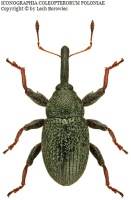Підтримуємо Вільну Україну
 We Support Free Ukraine
We Support Free Ukraine

Biodiversity Map
Taxa

-
Arthropodaphylum
Click to switch
to select orders
and filters > -
Hexapodasubphylum
Click to switch
to select orders
and filters > -
Insectaclass
Click to switch
to select orders
and filters > -
Coleopteraorder
Click to set
as the main taxon
and as a base
← of the left panel > -
Polyphagasuborder
Click to set
as the main taxon
and as a base
← of the left panel > -
Cucujiformiaseries
Click to set
as the main taxon
and as a base
← of the left panel > -
Curculionoideasuperfamily
Click to set
as the main taxon
and as a base
← of the left panel > -
Curculionidaefamily
Click to set
as the main taxon
and as a base
← of the left panel > -
Curculioninaesubfamily
Click to set
as the main taxon
and as a base
← of the left panel > -
Anthonominitribe
Click to set
as the main taxon
and as a base
← of the left panel > -
Anthonomusgenus
Click to set
as the main taxon
and as a base
← of the left panel > -
Anthonomidiussubgenus
Click to set
as the main taxon
and as a base
← of the left panel >
species:
Anthonomus (Anthonomidius) rubripes
PL
YES
name status: valid name
BioMap ID: 1046260
taxon code: 5983 (5335b)
taxonomy checked: YES
Polish Red List: DD
Data on distribution in Poland

Statistics
- Records: 10
- Publications: 3
- Collections: 1
- Publication authors: 5
- Illustrations (iconography): 1
- Photos (specimen/observation): lacking
Taxon description
Gatunek opisany z gór Taurus, rozciągających się wzdłuż granicy Turcji i Armenii; dotychczas notowany z tych krajów, z obszaru nadwołżańskiego w Rosji, z Bułgarii, Rumunii, wschodniej Ukrainy, południowej Słowacji, Austrii, Węgier, Macedonii i Włoch. W Polsce odkryty niedawno na jednym stanowisku na podstawie około 200 okazów złowionych 25 VII — 8 VIII 1997 r. na pięciorniku srebrnym — Potentilla argentea L. rosnącym na niewielkiej polanie śródleśnej. Omawiany chrząszcz pozbawiony zdolności lotu, uważany za gatunek stepowy, jest szeroko rozprzestrzeniony, ale występuje wyspowo i wszędzie rzadko spotykany. Stanowisko w Osowcu jest oddalone o przeszło 500 km od najbliżej znanego poza naszą granicą. Odkrywcy tego ryjkowca w Polsce, łowili go w południowej Słowacji na pięciorniku wyprostowanym — Potentilla recta L.
Illustrations
... browse
 Anthonomus
Anthonomusrubripes
External data sources
- Ostatnie rekordy
-
791740
 ○
○ Curculionidae: Anthonomus rubripes, PL, Pojezierze Mazurskie, Biebrzański P.N., podlaskie, UTM FE13, 1996, leg. M. Wanat (Wanat 2005d)
Curculionidae: Anthonomus rubripes, PL, Pojezierze Mazurskie, Biebrzański P.N., podlaskie, UTM FE13, 1996, leg. M. Wanat (Wanat 2005d) -
741881
 ×
× Curculionidae: Anthonomus rubripes, PL (Wanat et Szypuła 1998)
Curculionidae: Anthonomus rubripes, PL (Wanat et Szypuła 1998) -
598994
 ×
× Curculionidae: Anthonomus rubripes, PL, Pojezierze Mazurskie, Basen Środkowy, Biebrzański P.N., podlaskie, Osowiec Twierdza, UTM FE02, 1997, leg. M. Wanat (Wanat et Szypuła 1998)
Curculionidae: Anthonomus rubripes, PL, Pojezierze Mazurskie, Basen Środkowy, Biebrzański P.N., podlaskie, Osowiec Twierdza, UTM FE02, 1997, leg. M. Wanat (Wanat et Szypuła 1998) -
598784
 ×
× Curculionidae: Anthonomus rubripes, PL, Pojezierze Mazurskie, Basen Środkowy, Biebrzański P.N., podlaskie, Osowiec Twierdza, UTM FE02, 1997, leg. M. Wanat (Wanat et Szypuła 1998)
Curculionidae: Anthonomus rubripes, PL, Pojezierze Mazurskie, Basen Środkowy, Biebrzański P.N., podlaskie, Osowiec Twierdza, UTM FE02, 1997, leg. M. Wanat (Wanat et Szypuła 1998) -
598700
 ×
× Curculionidae: Anthonomus rubripes, PL, Pojezierze Mazurskie, Basen Środkowy, Biebrzański P.N., podlaskie, Osowiec Twierdza, UTM FE02, 1997, leg. M. Wanat (Wanat et Szypuła 1998)
Curculionidae: Anthonomus rubripes, PL, Pojezierze Mazurskie, Basen Środkowy, Biebrzański P.N., podlaskie, Osowiec Twierdza, UTM FE02, 1997, leg. M. Wanat (Wanat et Szypuła 1998) -
596709
 ×
× Curculionidae: Anthonomus rubripes, PL, Pojezierze Mazurskie, Basen Środkowy, Biebrzański P.N., podlaskie, Osowiec Twierdza, UTM FE02, 1998, leg. M. Wanat (Wanat 2005d)
Curculionidae: Anthonomus rubripes, PL, Pojezierze Mazurskie, Basen Środkowy, Biebrzański P.N., podlaskie, Osowiec Twierdza, UTM FE02, 1998, leg. M. Wanat (Wanat 2005d) -
596610
 ×
× Curculionidae: Anthonomus rubripes, PL, Podlasie, Basen Południowy, Biebrzański P.N., podlaskie, Osowiec Twierdza, UTM FE02, 1998, leg. M. Wanat
Curculionidae: Anthonomus rubripes, PL, Podlasie, Basen Południowy, Biebrzański P.N., podlaskie, Osowiec Twierdza, UTM FE02, 1998, leg. M. Wanat -
594797
 ×
× Curculionidae: Anthonomus rubripes, PL, Pojezierze Mazurskie, Basen Środkowy, Biebrzański P.N., podlaskie, Osowiec Twierdza, UTM FE02, 1999, leg. M. Wanat (Wanat 2005d)
Curculionidae: Anthonomus rubripes, PL, Pojezierze Mazurskie, Basen Środkowy, Biebrzański P.N., podlaskie, Osowiec Twierdza, UTM FE02, 1999, leg. M. Wanat (Wanat 2005d) -
591125
 ×
× Curculionidae: Anthonomus rubripes, PL, Pojezierze Mazurskie, Basen Środkowy, Biebrzański P.N., podlaskie, Osowiec Twierdza, UTM FE02, 2000, leg. M. Wanat (Wanat 2005d)
Curculionidae: Anthonomus rubripes, PL, Pojezierze Mazurskie, Basen Środkowy, Biebrzański P.N., podlaskie, Osowiec Twierdza, UTM FE02, 2000, leg. M. Wanat (Wanat 2005d) -
52620
 ⊡
⊡ Curculionidae: Anthonomus rubripes, PL, Podlasie, Osowiec-Twierdza, UTM FE02 (Wanat et Szypuła 1998, Burakowski et al. 2000)
Curculionidae: Anthonomus rubripes, PL, Podlasie, Osowiec-Twierdza, UTM FE02 (Wanat et Szypuła 1998, Burakowski et al. 2000) - ... more
- Powiązane publikacje
-
Wanat M. 2005d. Ryjkowce (Coleoptera: Curculionoidea bez Scolytinae) Biebrzańskiego Parku Narodowego i jego otuliny. [In:] Dyrcz A., Werpachowski C. (Eds.) Przyroda Biebrzańskiego Parku Narodowego. Osowiec Twierdza. pp. 301-324.
 Show records
Show records -
Burakowski B., Mroczkowski M., Stefańska J. 2000. Chrząszcze – Coleoptera. Uzupełnienia tomów 2-21. Katalog Fauny Polski, XXIII, 22, Warszawa.
 Show records
Show records -
Wanat M., Szypuła J. 1998. Interesujące gatunki ryjkowców (Coleoptera: Urodontidae, Curculionidae) ze wschodniej Polski. Wiad. Entomol., 17(2):85-94.
 full text
full text Show records
Show records
- Powiązane zbiory
-
Wanat M.
 Show records
Show records
- Wykaz powiązanych pozycji
-
Curculionoidea of Poland
 Show records
Show records




